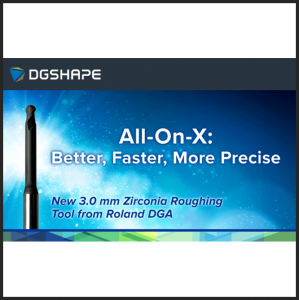
Zirconia treatment for efficient cementation process
Massimo Gagliani
Crown decementation are the most frequent failures in restorations using zirconia as an infrastructure. Increasing the roughness of the zirconia surface has been suggested to address this problem.
The purpose of this systematic review and meta-analysis was to evaluate yttria-stabilized tetragonal zirconia polycrystal surface roughness produced with aluminum oxide airborne-particle abrasion and the erbium yttrium aluminum garnet (YAG), neodymium-doped YAG, or CO2 laser
A huge number of papers has been analyzed according the standards of the systematic review and data were extracted from 17 studies.
Materials and methods
The first analysis of the subgroups was performed using the aluminum oxide airborne-particle abrasion and lasers.
The second analysis, methodologies were subgrouped into 4 modalities:
- polished with silicon carbide abrasive papers in the presintered stage and airborne-particle abrasion with aluminum oxide after the sintering process
- polished with silicon carbide abrasive papers in the presintered stage and airborne-particle abrasion with aluminum oxide after the sintering process
- polished with silicon carbide abrasive papers in the postsintered stage and airborne-particle abrasion with aluminum oxide after the sintering process
- no polish and airborne-particle abrasion with aluminum oxide after the sintering process.
The roughness was higher in the experimental groups submitted to surface treatment and the group that used airborne-particle abrasion in the presintered stage presented an effect size of 2.71 as the value of greater surface roughness.
Third analysis, the subgroups were examined according to the type of laser
The effect size favored the Nd:YAG laser as the highest surface roughness value, 4.15, when compared with the Er:YAG laser, 0.60.
Discussion
Techniques such as airborne-particle abrasion with aluminum oxide particles (Al2O3) were the most investigated surface treatment. In this systematic review, 94.7% of the airborne-particle abrasion was performed after the sintering process and only 5.3% before the sintering process. Airborne-particle abrasion with aluminum oxide before the sintering process was the most effective method because the presintered zirconia surface is softer.
Conclusions
Airborne-particle abrasion with aluminum oxide on presintered zirconia is currently the most efficient methodology.
Irradiation with the Er:YAG, Nd:YAG, and CO2 la- sers was destructive due to the formation of a melted surface, large cracks, and a carbonized layer with silver pigments.
Clinical Implications
Surface roughness is essential for the retention of dental restorations. These results provide a reference for the most researched and effective surface treatments.
For additional information: Evaluation of zirconia surface roughness after aluminum oxide airborne-particle abrasion and the erbium-YAG, neodymium-doped YAG, or CO2 lasers: A systematic review and meta-analysis
 Related articles
Related articles
Kuraray Noritake Dental Inc., a global leader in dental material innovation, today launched KATANA Zirconia ONE For IMPLANT at Dentsply Sirona World (DS World).
Products 22 September 2025
Roland DGA has introduced the ZDB-150D-US 3.0 mm roughing tool, developed specifically for full-arch zirconia applications.
This systematic review aimed to provide an overview of zirconia implants as well as regarding the outcome of the implant-restorative complex in preclinical studies.
Products 01 September 2025
Dentsply Sirona Releases Innovative CAD/CAM Zirconia Block and Abutment Resin Cement
The CEREC Cercon 4D Multidimensional Zirconia Abutment Block combines high strength with aesthetics for both hybrid abutments and hybrid abutment crowns.
Rocky diamond bur is engineered to help dentists stay in control when the case is tedious and time is tight
 Read more
Read more
Much like EMTs rushing to the scene after an accident, stem cells hurry to the site of a skull fracture to start mending the damage. A new finding has uncovered the signaling mechanism that triggers...
Products 05 November 2025
SimplyTest has launched a groundbreaking saliva-based test to detect high-risk strains of oral human papillomavirus (HPV), a major cause of oropharyngeal cancers.
News 05 November 2025
Perimetrics, Inc., a dental technology company pioneering quantitative diagnostics, announced today that the U.S. Food and Drug Administration (FDA) has granted clearance for the InnerView...
News 05 November 2025
On October 15, open enrollment for Medicare began nationwide. Hundreds of thousands of seniors in New Jersey will once again face the challenge of finding the right Medicare coverage, including the...
Digital Dentistry 04 November 2025
Digitalisation is an expanding field in dentistry and implementation of digital teaching methods in dental education is an essential part of modern education.















